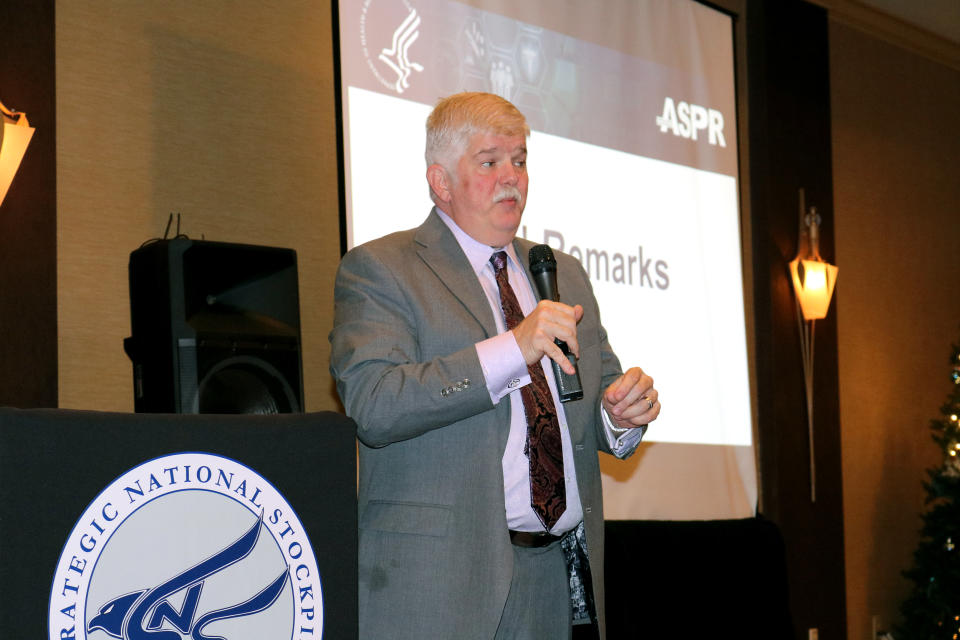Why the Strategic National Stockpile isn't meant to solve a crisis like coronavirus
As health care workers around the country labor under shortages of personal protective equipment, all eyes are on the Strategic National Stockpile — the country's largest repository of drugs and medical equipment for use in a public health crisis.
But the U.S. strategic stockpile isn't intended to be the solution to a crisis. It's designed to be used as a stopgap during emergencies. The stockpile has limited resources, government officials and public health experts say, which weren't at full capacity even before the coronavirus was on the horizon.
"The Strategic National Stockpile is not designed to be the sole solution to these problems," said Greg Burel, who directed the stockpile program for more than 12 years until his long-planned retirement in January. He said the shortages of personal protective equipment across the country — and the fact that states already need items from the stockpile — illustrate a systemwide failure in American health care.

"Right now, all of this market runs on a just-in-time basis, because it is optimized for the best possible cost," he said. "But sometimes getting the best possible cost leaves you in a position that you have the worst possible preparedness."
The Strategic National Stockpile, or SNS, is meant to be used for brief periods until the supply chain resumes normally, other supplies are manufactured or the president invokes the Defense Production Act, which President Donald Trump did Friday, to compel companies to make the most needed supplies.
Full coverage of the coronavirus outbreak
Formed in 1999, the stockpile employs 200 people who procure, store and distribute materials in times of emergency. Supplies are in "strategically located warehouses throughout the country ready for deployment," although the number of warehouses and their locations are closely guarded secrets for national security reasons, officials with the Department of Health and Human Services told NBC News.
The stockpile wasn't at full capacity before the COVID-19 outbreak in the U.S., in part because it never fully replenished some of the critical supplies used in the 2009 H1N1 pandemic response, Burel said. During that crisis, at least 25 percent of the supply of antiviral drugs designated for influenza were used, as well as a significant amount of personal protective equipment — the very supplies hospitals are in dire need of right now.
HHS said that it has it has maintained supplies of personal protective equipment in the stockpile and that it has made several additional purchases, but "priorities for SNS inventory are balanced against congressionally available funding and direction."
"That stock was never replenished because we never received additional appropriations," Burel said. "We are not in the optimum situation right now."
It's estimated that $8 billion worth of vaccines, antibiotics, medical equipment and protective supplies are typically in the stockpile, designed to respond to a variety of scenarios. But the stockpile is limited by its annual — and occasionally supplemental — funding from Congress.
"What we try to do in the Strategic National Stockpile is use the appropriated funds that Congress gives us to invest in the best way we can," Burel said. "We are never going to have everything that you would like to have on that shelf. It's just too expensive."
HHS said that it has been "transparent that more supplies are needed" and that it has requested additional funding to procure more and scale up production.
"The role at the federal level is to appropriately implement regulatory relief, provide alternative sources and support manufacturing, and adjust allocation to appropriately target areas in need," the agency said in a statement. "Local hospitals must do their part to make sure product goes where it's needed now rather than being stored where it is not currently needed."
Materials from the stockpile are being distributed in proportion to the population in a given jurisdiction, calculated using 2010 data, an HHS spokesperson said. States are getting their full allocations, although that may not meet their needs. Some areas of higher transmission of coronavirus may receive extra supplies on top of their population-based quotas.
Download the NBC News app for breaking news and politics
Watching the pandemic response unfold from outside government, Burel said he's concerned that health care facilities and state public health departments don't maintain adequate supplies of critical material for use in the event of a supply chain disruption or an increase in demand.
"I think ultimately we have something that we've got to face. And that is: Every point in the supply chain for those kind of materials has got to develop some kind of cushion, whether we call it safety stock, back stock, whatever it is," said Burel, who decided in the fall to retire after 38 years in government service — long before the coronavirus began sweeping the globe.
Additional funding and preparation need to occur at the state and local levels, Burel said, as well as at individual health care facilities and providers, to ensure that supplies are available to those who need them most. And they need to plan far ahead. In some cases, it can take years to replenish certain drugs, he said.
Looking forward, Burel's message to lawmakers regarding the stockpile is simple: "Fund it."
"You've got a fantastic asset that's being operated by some of the most dedicated professional people I have ever known in my life. Fund it," Burel said. "Make sure it can do what it needs to do."

